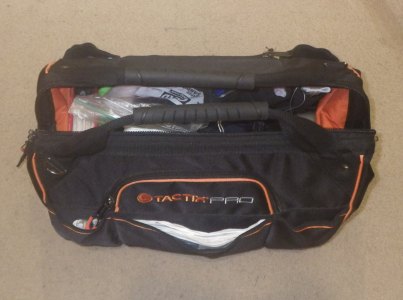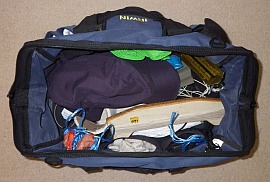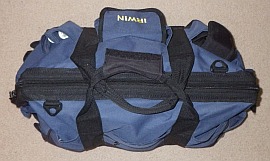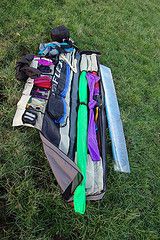- Home Page
- Accessories
- Kite Bag
The Humble Kite Bag
Simple Calico Bags & Fancier Solutions
Not surprisingly, there's a style of kite bag which corresponds to most of the major kite categories.
Perhaps I'm a little unusual in that I avoided even using a bag for quite a while. No, really. All these homemade kites used to lie around here, stacked against walls or hanging from walls like pictures. Our house used to be something of a wood-and-plastic-kite museum. And yet, we tended to go out with just one or two kites at a time, depending on conditions—three at the most.
A person once asked me "how many kites have you actually made?" Back then, the answer was something like "40 or 50." That included some not-so-successful prototypes. Years later, the answer would probably have been well into triple digits :-0. Again, that would have included prototypes that were flown a couple of times and then discarded.
On this site, there's more kite-making info than you can poke a stick at :-)
Want to know the most convenient way of using it all?
The Big MBK E-book Bundle is a collection of downloads—printable PDF files which provide step-by-step instructions for many kites large and small.
Every kite in every MBK series.
 Builder's bag
Builder's bagBack to bags now...
For at least a couple of years I was in the habit of using a 30 cm (12 in.) tall calico shopping bag to carry
- winders (20- and 50-pound line)
- digital camera
- wind meter
- spring scales for observing line tension
- sun hat
- repair tape
- scissors
- hammer and stakes for anchoring a reel (200-pound line)
The big garden-hose reel was carried separately of course, if it was
needed at all. And the kites were just rolled up and sat nicely between
the handles of the bag as I walked out to the launch area.
Later, builders' carry-bags replaced the calico bag. See the most recent one above and an older one below, where the photos were taken from above.
The major advantage of these bags was the multitude of pockets of various sizes and shapes. This was absolutely ideal for keeping most of the bits and pieces neatly separated and easy to find.
And the handles used to come in handy for holding a rolled-up kite or two while walking to the launch area.
 Builder's carry bag
Builder's carry bag ... has pockets inside and out
... has pockets inside and outOut of curiosity, I did a little research to see what kinds of bags are out there. How were people using them? Here they all are:
Surfing Kites
And Other Power Kites
We're talking kites such as soft stunters and traction parafoils. Being of soft construction, the bags for these can be quite compact rather than long and thin as for sparred kites.
A new traction parafoil or surfing inflatable kite is sold with a bag of course, and it usually includes flaps or compartments for storing the various accessories needed. The latest products are designed to be as light as possible, while still being rugged enough for the job. Sometimes compression straps are included, to squeeze the whole thing down to a more manageable size.
What if you have multiple kites, and the purpose-built bags seem rather expensive?
Sniffing around a few forums led to the discovery that an economical option for many kite surfers is the golf bag! Some are too heavy, but others are actually well-suited to carting around a load of gear. Stories abound of how people get past airport scrutiny... Some go as far as including a golf club or two! The weight is the main issue though.
Another trend is the sale of a kite bag that swallows entire boards as well! It's not so compact, but at least everything is together.
If the kite is old and second or third hand perhaps, the original bag might have gone missing. Hence, some kiters make their own from hard-wearing materials such as Cordura or nylon. A few of the keener ones have even drawn up plans and published them online.
Nylon and polyester are also good choices for sewing thread. These materials are far less prone to rot when moist, like cotton for example!
Sparred Stunt Kites
The keenest of these guys like to travel with an entire collection of kites. Roll-up bags are the norm here, with pockets to keep multiple kites separate and often extra smaller pockets for accessories. Modern touches include Velcro flaps to keep things secure and a padded shoulder strap for convenience. Also, if the pockets are made of mesh at one end, dry sand and debris can easily drop out. Very helpful!
Now there are bags and there are top of the range bags out there for well-heeled stunt flyers. Bags that are, and I quote "beautifully embroidered." You can spend more on one of these bags than I would have spent on a very good single-liner! But I guess it's not surprising, since competition-grade stunt kites are priced in the 100s of dollars. A fully packed bag could be worth several thousand.
Other kiters are not so fussy and are content with a long, thin bag that everything can just be tossed into. This is probably practical enough for just a couple of kites and minimal accessories like a winder and some repair tape.
Besides the fit-all style of roll-up kite bag, some are purpose designed for a series of stacked kites. I suppose the entire stack could be sold with the bag.
Again, some people have published plans online for these bags. Are you the DIY type? If not overly fancy, a bag can be made in less than a day, for low cost.
Single-Line Soft Kites
Like the steerable parafoils, these kites can pack down to a very compact size for transport. Although most would come with a bag when sold new, there are a few options for substitute bags. For example, those clear-plastic quilt-storage bags available in department stores. Another (much smaller) plastic bag can be used for any extra bits and pieces.
Simple "stuff bags" would be ideal for this kind of kite as well.
Sparred Single Liners
 A roll-up bag
A roll-up bagThis is a bit closer to home for me. Roll-up bags are used by many single-line flyers too. It makes sense, if you are in the habit of going out with several kites for each flying session.
In fact, it appears the roll-up kite bag is used interchangeably for both stunt kites and single liners. Both types of kites break down to long, thin packages after all.
The photo of the roll-up bag is courtesy of Ross Goodman.
Laid out on the grass, a kite bag like this is also handy as a work-bench, in case small repairs or mods need to be carried out. It makes it harder to lose small bits and pieces like rolls of tape or fittings.
Some good-quality single liners are sold with their own carry bag.
My ideal bag? Perhaps a 1.5 meter (5 foot) long thing, zipped along its length. With padded compartments for digital camera and wind meter. Another compartment could be for small bits and pieces, mainly repair tape. Perhaps there could also be an internal fold-over Velcro strap to secure a couple of line winders. Maybe the broad-brimmed hat could get tossed in there as well! It sure looks a bit weird driving along wearing one of those :-)
Question: Do you need to own and use a kite bag to be considered a "serious" kite flyer? It's a slightly tongue-in-cheek question, but I guess the answer might be Yes. Ooops, I never did end up using a purpose-made kite bag...
As mentioned earlier, there's more kite making on this site than you can poke a stick at. :-)
Want to know the most convenient way of using it all?
The Big MBK E-book Bundle is a collection of downloads—printable PDF files that provide step-by-step instructions for many kites large and small.
That's every kite in every MBK series.
